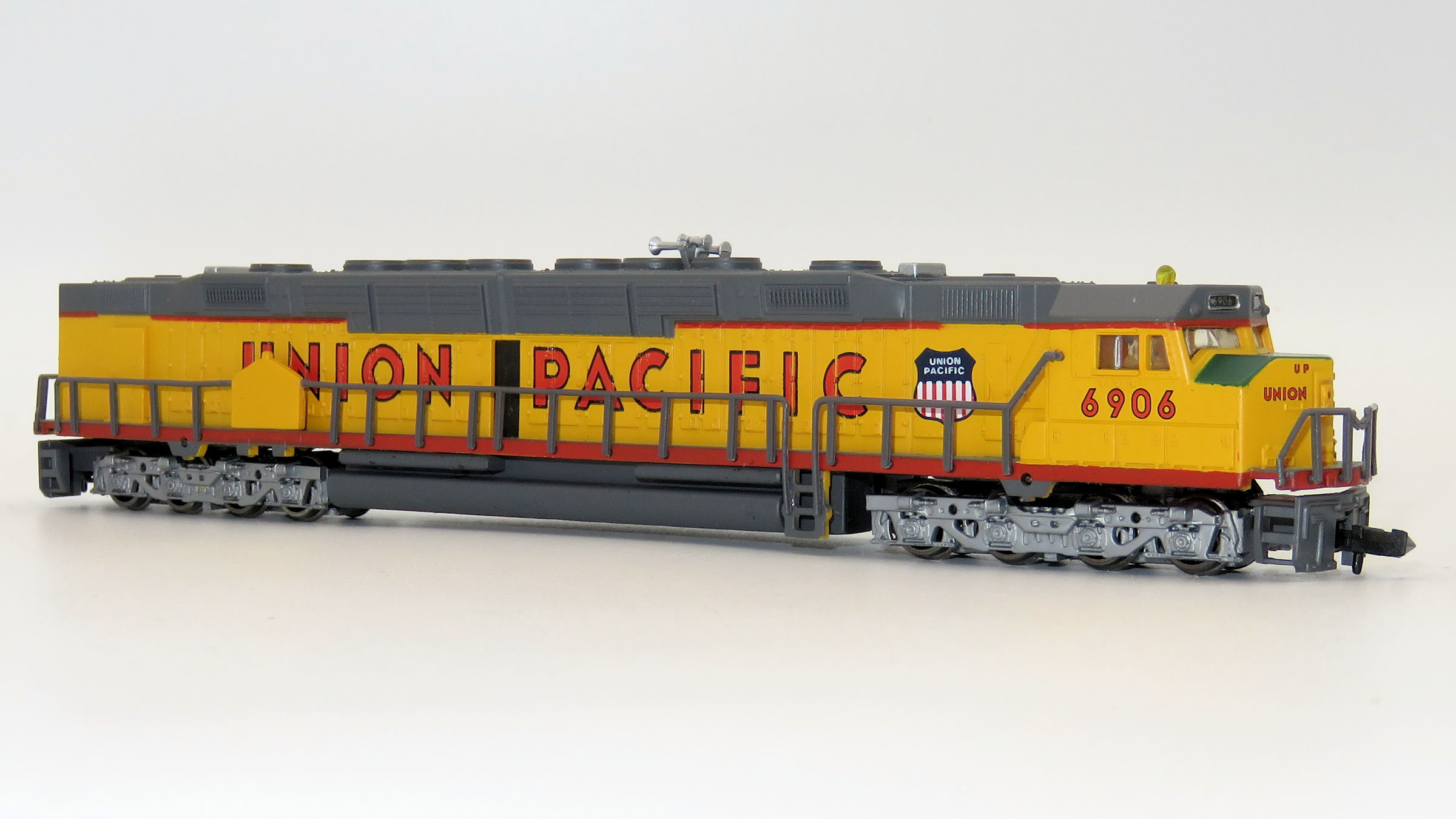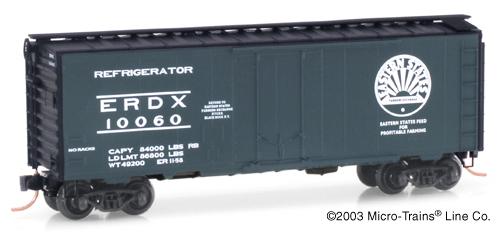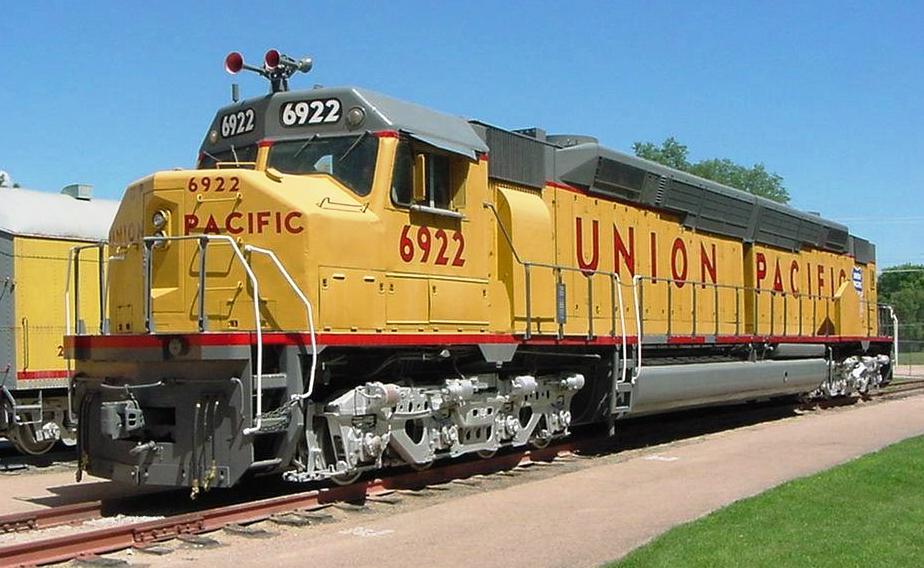Model Information: This is a model of the largest Diesel Locomotive ever made. This model has been released in several versions that are radically different one from each other.
- 1984 - initial release: a quite toyish version, with a single skew-wound 3-pole motor, traction tires and Rapido couplers. Quite noisy! The only good point is that the through-hole between the two parts of the loco is for real! Painted top nose in gray, whereas if should be green. The rotary beacon is operational.
- 1995 - brand new release with 2 skew-wound 5-pole motors, no traction tires. Still Rapido couplers. Running more quietly. Top nose is accurately painted green. "Plus"/"Spectrum" range.
- 2009 - new dual-mode DCC version, with a new chassis with 2 straight-wound 3-pole motors and four flywheels ! These decoders enable operation with a standard DC analog power pack or any NMRA-compliant Digital Command Control system. This DCC-equipped N scale EMD DD40AX has speed, direction, and lighting control and is offered in three Union Pacific road numbers. "Blue label" range.
- 2014 - same as the 2009 model, but offered with factory installed SoundTraxx sound decoder. Runs smoothly with decent sound. All light effects can be controlled separately (lights, rotary beacon, number boards).
DCC Information:
- The 1984 and 1995 versions are DCC-nothing. However due the split frame chassis and enough space left, adding a wired decoder should be fairly easy.
- The 2009 version comes with DCC (no sound) already installed.
There is a provision to add a speaker in the fuel tank, so adding a sound decoder will not require milling; but the factory installed decoder is soldered to the circuit board (no connector) so you won't escape from using a soldering iron.
An example of sound decoder installation can be found on this site. - The 2014 versions comes with DCC and Sound, so unless you don't like the Soundtraxx Tsunami sound, just run the loco!
Prototype History: The model designation, DDA40X (or DD40AX), comes from two D (four axle) trucks, A for a cab, 40 to indicate the use of the 16-cylinder 645E3 engine as in the GP40 and SD40, and X to indicate some experimental features. The first of the experimental features was an uprating of the 645E3 engine from 3,000-horsepower to the 645E3A engine with 3,300 horsepower. Another feature was the ability to perform a self-load test (checking that the alternator was producing power) without an external load test box to absorb the electrical power created. Next there was the usage of modular control circuits replacing considerable amounts of wiring. There was one other major difference between the Centennials and most regular freight units and that was the use of the 59:18 gear ratio that allowed 90 MPH operation instead of the standard 62:15 ratio that had a maximum of 75 miles per hour.
The DDA40X was a massive locomotive, 98 feet, 5 inches long, 17 feet four inches tall with 8,200-gallon fuel tanks and an operational weight of 545,432 pounds. They were delivered on two orders: the first order was for 25 units, numbers 6900 through 6924, delivered between April and December 1969. The second order was for 22 units, numbers 6925 through 6946, delivered between June 1970 and September 1971. Each cost $551,168.
Over the years, the Centennials underwent various modifications. The horns were originally mounted between the first and second radiator fans. Later they were moved to the cab roof. Two units were equipped with sirens as an experimental means of warning maintenance of the way personnel of the approaching train. Various types of strobe lights, flashers, and rotary beacons were installed on the DDA40Xs to make them more visible. Number 6936, still operating in UP's Heritage Fleet, was modified with exposed bearings on the trucks, air conditioning and a new nose door following a grade crossing collision on.
Thirteen examples survive, including one unit (6936) which is still in service with Union Pacific.
Read more on Wikipedia
The DDA40X was a massive locomotive, 98 feet, 5 inches long, 17 feet four inches tall with 8,200-gallon fuel tanks and an operational weight of 545,432 pounds. They were delivered on two orders: the first order was for 25 units, numbers 6900 through 6924, delivered between April and December 1969. The second order was for 22 units, numbers 6925 through 6946, delivered between June 1970 and September 1971. Each cost $551,168.
Over the years, the Centennials underwent various modifications. The horns were originally mounted between the first and second radiator fans. Later they were moved to the cab roof. Two units were equipped with sirens as an experimental means of warning maintenance of the way personnel of the approaching train. Various types of strobe lights, flashers, and rotary beacons were installed on the DDA40Xs to make them more visible. Number 6936, still operating in UP's Heritage Fleet, was modified with exposed bearings on the trucks, air conditioning and a new nose door following a grade crossing collision on.
Thirteen examples survive, including one unit (6936) which is still in service with Union Pacific.
Read more on Wikipedia
Road Name History: The Union Pacific Railroad (reporting mark UP) is a freight hauling railroad that operates 8,500 locomotives over 32,100 route-miles in 23 states west of Chicago, Illinois and New Orleans, Louisiana. The Union Pacific Railroad network is the largest in the United States and employs 42,600 people. It is also one of the world's largest transportation companies.
Union Pacific Railroad is the principal operating company of Union Pacific Corporation (NYSE: UNP); both are headquartered in Omaha, Nebraska. Over the years Union Pacific Corporation has grown by acquiring other railroads, notably the Missouri Pacific, Chicago & North Western, Western Pacific, Missouri-Kansas-Texas, and the Southern Pacific (including the Denver & Rio Grande Western).
Union Pacific Corporation's main competitor is the BNSF Railway, the nation's second largest freight railroad, which also primarily services the Continental U.S. west of the Mississippi River. Together, the two railroads have a duopoly on all transcontinental freight rail lines in the U.S.
Read more on Wikipedia and on Union Pacific official website.
Union Pacific Railroad is the principal operating company of Union Pacific Corporation (NYSE: UNP); both are headquartered in Omaha, Nebraska. Over the years Union Pacific Corporation has grown by acquiring other railroads, notably the Missouri Pacific, Chicago & North Western, Western Pacific, Missouri-Kansas-Texas, and the Southern Pacific (including the Denver & Rio Grande Western).
Union Pacific Corporation's main competitor is the BNSF Railway, the nation's second largest freight railroad, which also primarily services the Continental U.S. west of the Mississippi River. Together, the two railroads have a duopoly on all transcontinental freight rail lines in the U.S.
Read more on Wikipedia and on Union Pacific official website.
Brand/Importer Information: Bachmann Industries (Bachmann Brothers, Inc.) is a Bermuda registered Chinese owned company, globally headquartered in Hong Kong; specializing in model railroading.
Founded in Philadelphia, Pennsylvania, the home of its North American headquarters, Bachmann is today part of the Kader group, who model products are made at a Chinese Government joint-venture plant in Dongguan, China. Bachmann's brand is the largest seller, in terms of volume, of model trains in the world. Bachmann primarily specializes in entry level train sets, and premium offerings in many scales. The Spectrum line is the high quality, model railroad product line, offered in N, HO, Large Scale, On30, and Williams O gauge all aimed for the hobbyist market. Bachmann is the producer of the famous railroad village product line known as "Plasticville." The turnover for Bachmann model trains for the year ended 31 December 2006 was approximately $46.87 million, a slight increase of 3.36% as compared to 2005.
Founded in Philadelphia, Pennsylvania, the home of its North American headquarters, Bachmann is today part of the Kader group, who model products are made at a Chinese Government joint-venture plant in Dongguan, China. Bachmann's brand is the largest seller, in terms of volume, of model trains in the world. Bachmann primarily specializes in entry level train sets, and premium offerings in many scales. The Spectrum line is the high quality, model railroad product line, offered in N, HO, Large Scale, On30, and Williams O gauge all aimed for the hobbyist market. Bachmann is the producer of the famous railroad village product line known as "Plasticville." The turnover for Bachmann model trains for the year ended 31 December 2006 was approximately $46.87 million, a slight increase of 3.36% as compared to 2005.
Item created by: Alain LM on 2018-03-30 12:55:43. Last edited by Alain LM on 2020-10-11 16:06:54
If you see errors or missing data in this entry, please feel free to log in and edit it. Anyone with a Gmail account can log in instantly.
If you see errors or missing data in this entry, please feel free to log in and edit it. Anyone with a Gmail account can log in instantly.












